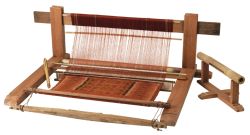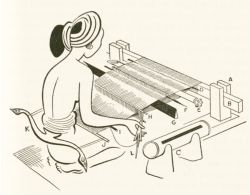Cagcag
- loom horizontal backstrap loom operated by a person sitting at one end of the warp threads with these threads attached to a frame worn around the back of the operator so that tension of warp threads can be maintained by leaning backwards en

Cagcag. Makers: Ngurah Hendrawan, Ni Gede Diari, and Wayan Paing, Nusa Penida, Bali, Indonesia, 2017. Wood, bamboo, cotton. This loom is a body-tension or backstrap loom. It features a discontinuous warp setup with a wooden harness, breast-and-cloth beam, beater/blade, reed, lease bar, heddle rod and heddle strings, and a bamboo shuttle that contains the bobbin with ikat yarn. The wooden harness rests on the lower back of the weaver and is attached to the loom with cords. On the loom is a partially woven cepuk, or ritual cloth, which is used in a variety of ceremonies.

“Loom (Prabot Tennun),” from Miguel Covarrubias, Island of Bali (New York: Knopf, 1947), p. 3. The process of weaving requires a mechanism to keep the warp taut and a method to create an opening or shed between specific warp threads, through which a shuttle can be passed to create the weft. In a backstrap loom, the weaver’s body is integrated with the loom. The weaver, usually a woman provides the force needed to keep the warp as taut or relaxed as needed, as well as the motion required to lift the string heddles and create the shed. Many of the small gestures that weavers use to create textiles are passed from mother to daughter. Traditionally, the loom was also inherited in this manner, and the weaving blade or beater was emblematic of women’s skill and productivity.





